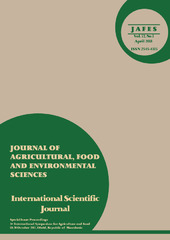Приказ основних података о документу
Pollen viability in quince cultivars
| dc.creator | Radović, Aleksandar | |
| dc.creator | Nikolić, Dragan | |
| dc.creator | Milatović, Dragan | |
| dc.creator | Rakonjac, Vera | |
| dc.creator | Bakić, Ivana | |
| dc.date.accessioned | 2022-07-14T08:46:40Z | |
| dc.date.available | 2022-07-14T08:46:40Z | |
| dc.date.issued | 2018 | |
| dc.identifier.issn | 2545-4315 | |
| dc.identifier.uri | http://aspace.agrif.bg.ac.rs/handle/123456789/6126 | |
| dc.description.abstract | Pollen viability of eight quince cultivars (ʻLeskovackaʼ, ʻVranjskaʼ, ʻMoravaʼ, ʻPazardzijskaʼ, ʻHemusʼ, ʻAsenicaʼ, ʻPortugalʼ and ʻTriumphʼ), was studied in the two-year period (2011-2012). Testing of pollen viability was performed using two methods: the staining of pollen with acetocarmine (indirect method) and pollen germination in vitro with sucrose and agar-agar (direct method). Studied cultivars differed significantly in terms of pollen viability. The lowest percentage of stained pollen grains was detected in ʻLeskovackaʼ cultivar (70.29%) and the highest in the cultivars ʻAsenicaʼ, ʻHemusʼ and ʻTriumphʼ (over 90%). Similarly to that, the lowest percentage of pollen germination was obtained in ʻLeskovackaʼ cultivar (62.86%) and the highest in the cultivars ʻMoravaʼ, ʻAsenicaʼ, and ʻTriumphʼ (over 80%). With the exception of ʻPortugalʼ cultivar, the values of pollen viability determined by staining with acetocarmine were higher for 3-15% compared to the pollen germination in vitro. However, values obtained using these tho methods are highly positively correlated. On the basis of obtained results, the both methods can be recommended as reliable tests for pollen viability of quince, although priority should be given to the method of pollen germination in vitro, because it is more accurate. All tested cultivars are distinguished for high pollen viability, and can be successfully used as male parents in hybridization. In addition, they also can be recommended as a good pollenisers when are planting new quince orchards. | sr |
| dc.language.iso | en | sr |
| dc.publisher | “Ss. Cyril and Methodius" University in Skopje, Faculty of Agricultural Sciences and Food-Skopje | sr |
| dc.relation | info:eu-repo/grantAgreement/MESTD/Technological Development (TD or TR)/31063/RS// | sr |
| dc.rights | openAccess | sr |
| dc.rights.uri | https://creativecommons.org/licenses/by/4.0/ | |
| dc.source | Journal of Agricultural, Food and Environmental Sciences | sr |
| dc.subject | Cydonia oblonga | sr |
| dc.subject | pollen staining | sr |
| dc.subject | pollen germination in vitro | sr |
| dc.subject | breeding | sr |
| dc.title | Pollen viability in quince cultivars | sr |
| dc.type | article | sr |
| dc.rights.license | BY | sr |
| dc.citation.epage | 71 | |
| dc.citation.issue | 1 | |
| dc.citation.spage | 68 | |
| dc.citation.volume | 72 | |
| dc.identifier.fulltext | http://aspace.agrif.bg.ac.rs/bitstream/id/23892/Pollen_viability_in_pub_2018.pdf | |
| dc.identifier.rcub | https://hdl.handle.net/21.15107/rcub_agrospace_6126 | |
| dc.type.version | publishedVersion | sr |


